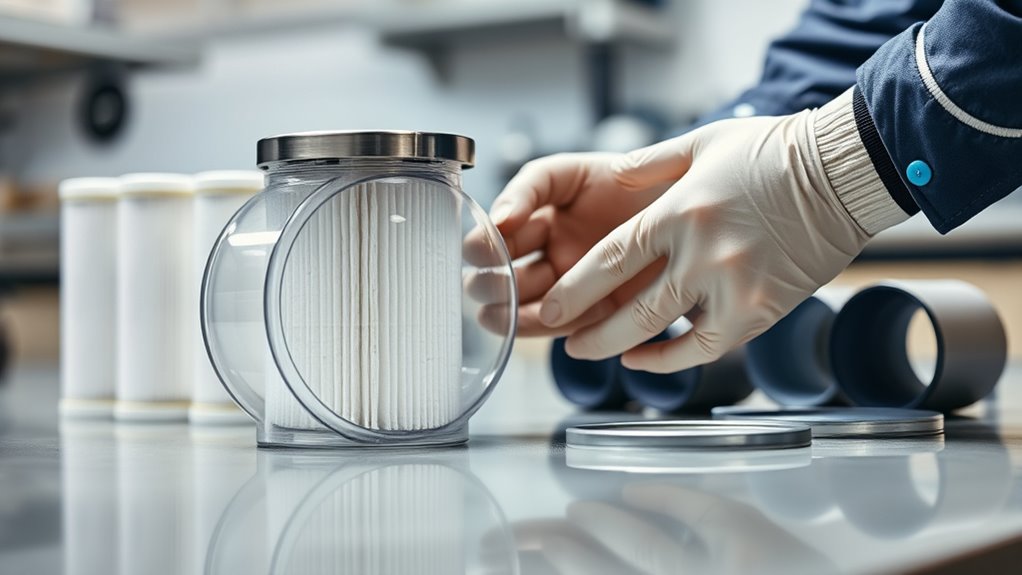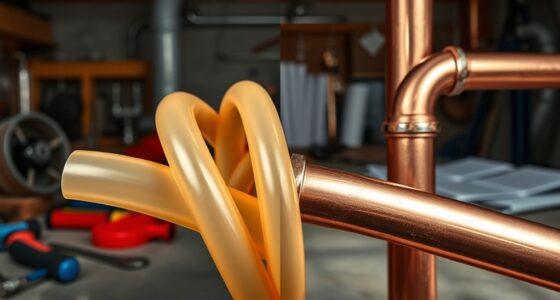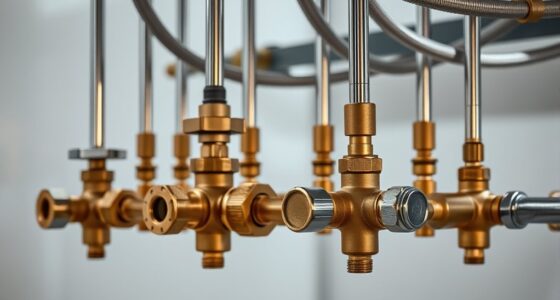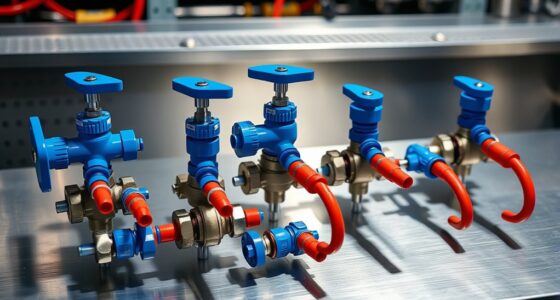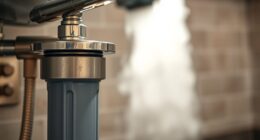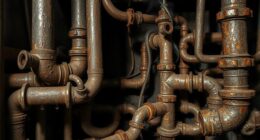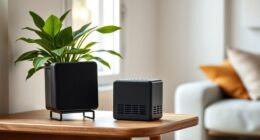Maintaining your pre filter housings and cartridges is simple and key to keeping your water filter working well. You should watch for signs like reduced flow, foul odors, or visible dirt on the filter. To replace, turn off the water, open the housing, remove the old cartridge, rinse the housing, and insert a new filter. Regular cleaning and choosing the right cartridge help extend your system’s life. If you want to learn more tips, keep going.
Key Takeaways
- Regularly check for signs like reduced water flow or strange taste to identify when filters need attention.
- Turn off water, open the housing carefully, remove the old cartridge, and replace it with a compatible new one.
- Clean the filter housing thoroughly before installing a new cartridge to prevent debris buildup.
- Ensure the cartridge matches your water needs and is compatible with your system for optimal performance.
- Follow safety guidelines and seek professional help for complex components or if you notice equipment issues.
Understanding What Pre Filter Housings and Cartridges Do
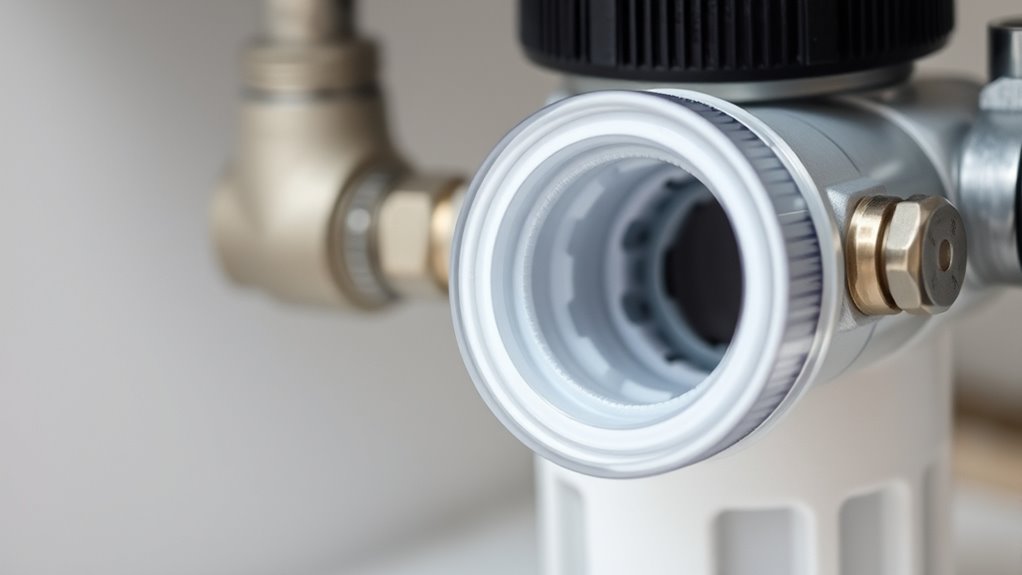
Pre filter housings and cartridges play a vital role in protecting your main water filtration system. They act as the first line of defense, trapping larger particles and sediments before water reaches your primary filters. This helps extend the filter lifespan and guarantees optimal performance. Proper maintenance of these components is essential for effective contaminant removal, including dirt, rust, and debris. When functioning correctly, they prevent clogging and reduce strain on your entire system. Understanding their role helps you appreciate the importance of regular checks and timely replacements. Additionally, utilizing monitoring systems can help detect potential issues early and ensure consistent performance. By keeping your pre filter housings and cartridges in good condition, you maximize their efficiency, ensuring cleaner water and a longer-lasting filtration system. This proactive approach safeguards your investment and promotes healthier water quality.
Signs That Your Pre Filter Needs Attention
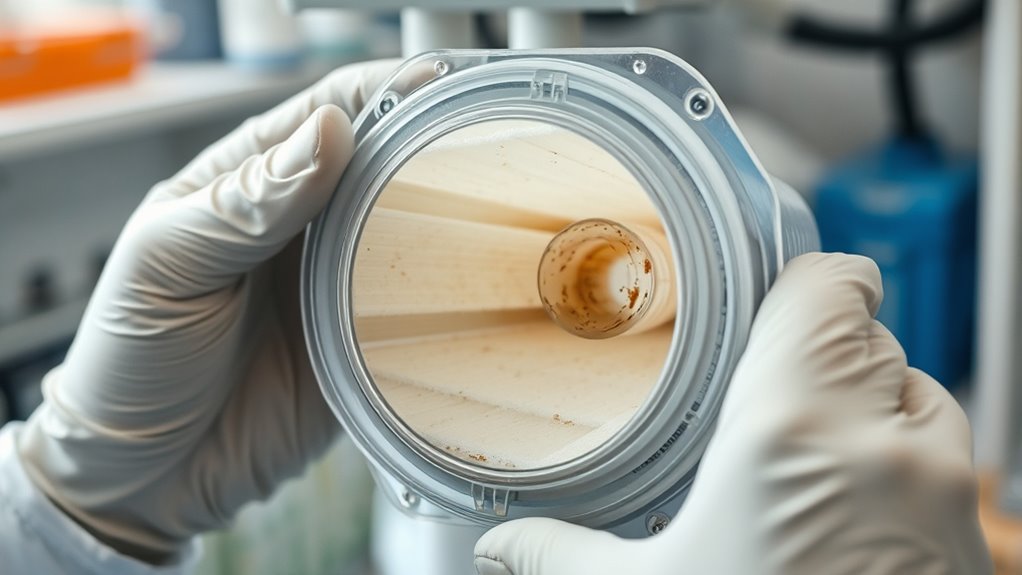
Regularly inspecting your pre filter housings and cartridges helps make certain they’re working properly. Signs that your pre filter needs attention include a decreased filter lifespan, which means the filter isn’t lasting as long as it should. You might also notice a change in water taste, often becoming more mineral-like or off-putting. Additionally, visible dirt or debris on the filter indicates it’s clogged and needs replacing. Reduced water flow or pressure can also signal a clogged filter. Use the table below to identify common signs:
| Sign | What it Means |
|---|---|
| Short filter lifespan | Filter is clogged or overused |
| Water taste changes | Contaminants bypass the filter |
| Visible dirt or debris | Filter needs cleaning or replacement |
| Reduced water flow/pressure | Clogged or saturated filter |
| Unusual water color or smell | Filter is overdue for maintenance |
Step-by-Step Guide to Replacing Your Pre Filter Cartridge
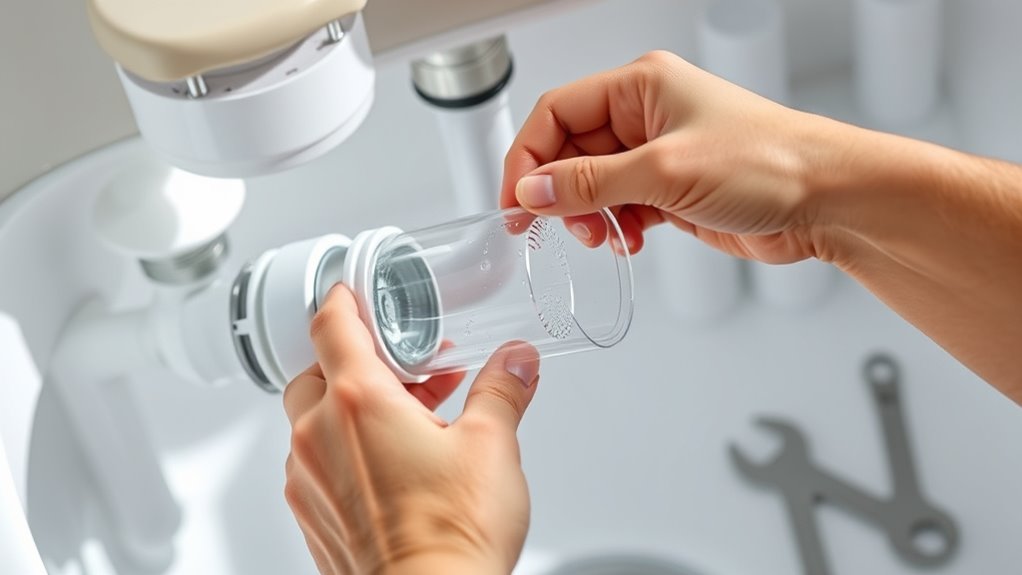
Replacing your pre filter cartridge is a straightforward process that guarantees your water filtration system continues to operate effectively. First, turn off the water supply and release any pressure by opening the faucet. Next, open the filter housing carefully, using a wrench if needed. Remove the old cartridge and dispose of it properly. Check the filter’s lifespan and replace it based on the recommended replacement frequency, usually every 6 to 12 months, depending on water quality and usage. Rinse the housing to remove any debris before inserting the new cartridge. Make sure it sits firmly in place, then close the housing tightly. Turn the water back on, and check for leaks. Regular replacement keeps your system functioning at its best and ensures clean, fresh water. Additionally, consulting your system’s media guide can help determine the appropriate cartridge type for your water conditions.
How to Clean and Maintain Your Pre Filter Housing
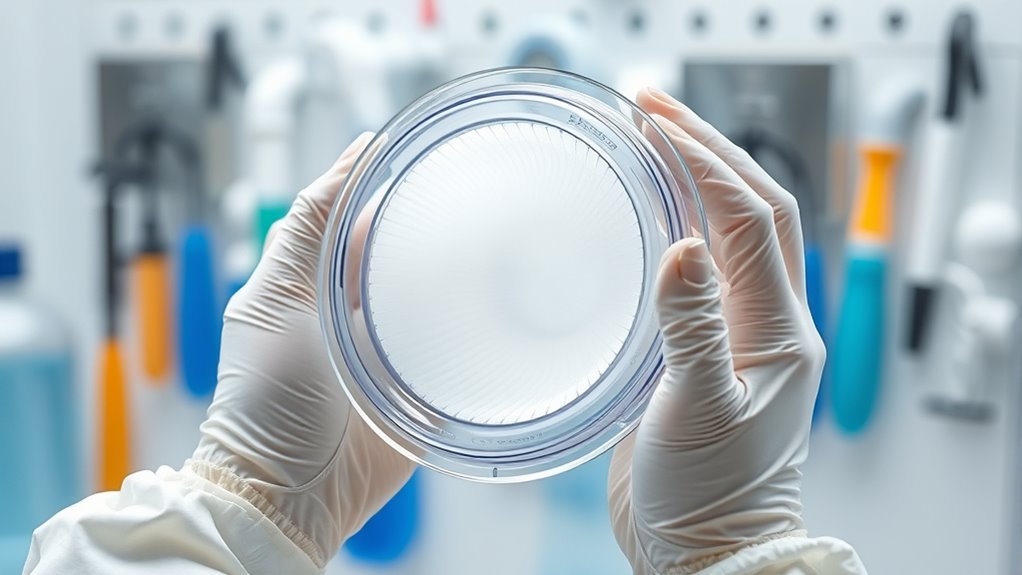
To maintain your pre filter housing in good shape, start by turning off the water supply to prevent leaks. Next, remove the cartridge and clean the housing thoroughly. Finally, reassemble the system and run a test to guarantee everything works smoothly. Regular maintenance can also help prevent false alarms and ensure your system’s reliability.
Turn Off Water Supply
Before you start cleaning your pre filter housing, turning off the water supply is essential. This step prevents water from rushing in and causing messes or damage. Imagine the water pressure suddenly stopping; it’s like closing a valve to keep everything dry. To visualize, think of this:
| Water Flow | Water Off |
|---|---|
| Water pressure builds | Water pressure drops |
| Flowing water | No water flow |
| Risk of leaks | Safe to work |
| Potential spills | Clean workspace |
| System ready | Maintenance begins |
Turning off the water ensures you don’t compromise your filter’s lifespan by exposing it to unnecessary pressure or debris during cleaning. It also makes the process smoother and safer, preventing unexpected water damage. Additionally, proper maintenance procedures help extend the life of your system and ensure optimal performance.
Remove and Clean Cartridge
Once the water supply is shut off, carefully remove the cartridge from the housing by unscrewing or pulling it out, depending on your system’s design. This step is essential for effective filter replacement and cartridge cleaning. Before cleaning, inspect the cartridge for damage or excessive buildup. When cleaning, avoid harsh chemicals that could damage the filter media. Instead, rinse the cartridge gently with clean water, removing dirt and debris. If the cartridge is heavily soiled, consider soaking it in a mild cleaning solution, then rinse thoroughly. Remember, a clean cartridge guarantees ideal water flow and filtration efficiency. Regular maintenance extends the lifespan of your filter system and maintains water quality. Handle the cartridge carefully to prevent any damage during removal or cleaning. Additionally, ensure that the ventilation system is functioning properly to prevent buildup of dangerous gases like carbon monoxide.
Reassemble and Test System
After cleaning the cartridge, reassemble the housing by carefully placing the filter back into position and tightening the housing securely to prevent leaks. Confirm all parts are aligned correctly before sealing. Once reassembled, perform system testing to verify everything functions properly. Check for leaks around the housing and ensure the filter replacement was successful. Run water through the system and observe for any irregularities or pressure drops. If you notice leaks or reduced flow, double-check the housing seal and re-tighten if necessary. Proper reassembly and thorough testing help maintain your pre filter’s efficiency and prolong its lifespan. Regular system testing after filter replacement guarantees your system operates at peak performance and reduces the risk of contamination or damage. Proper maintenance ensures your system remains reliable and extends the lifespan of your filters and housing.
Tips for Choosing the Right Pre Filter Cartridge
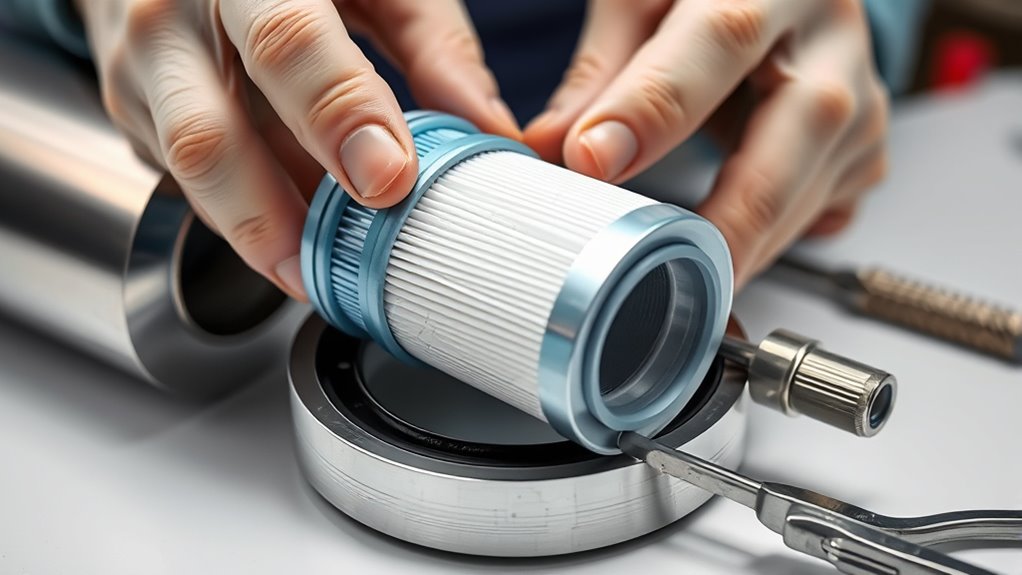
Choosing the right pre filter cartridge is essential for effective water filtration, and it starts with understanding your specific needs. You need to evaluate factors like the filter material and cartridge size to guarantee optimal performance.
To make an informed choice, keep these tips in mind:
- Match the filter material to your water quality, such as sediment or chlorine removal.
- Select a cartridge size that fits your housing unit and water flow rate.
- Check compatibility with your existing system.
- Consider the lifespan of the filter material and how often you’ll need to replace it.
- Evaluate your budget and maintenance preferences for long-term costs.
- Regularly monitor and follow maintenance schedules to ensure sustained filtration effectiveness filter maintenance.
Focusing on these aspects helps you pick a cartridge that offers the best filtration, durability, and value for your specific water needs.
When to Call a Professional for Help
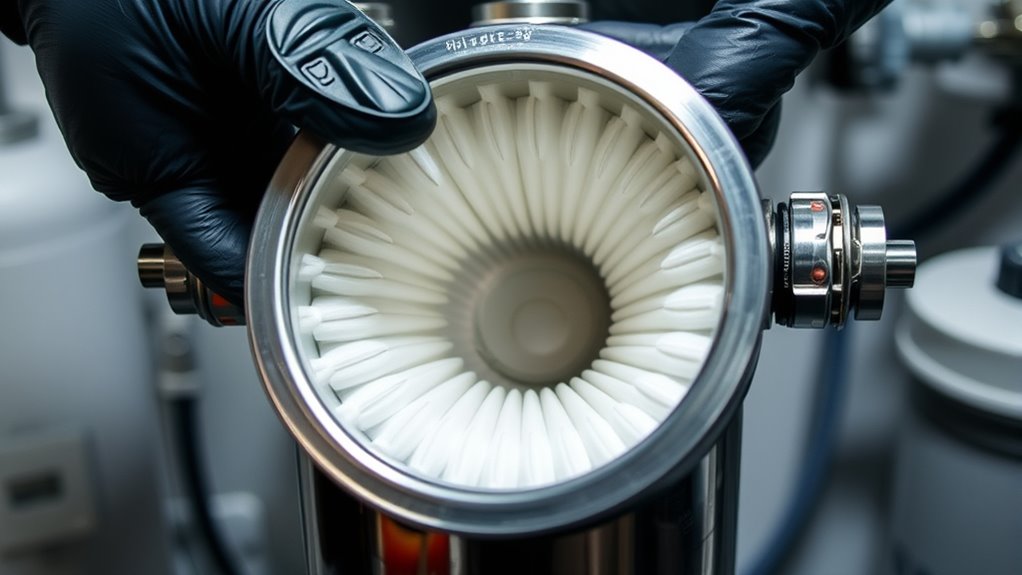
If you notice signs of equipment trouble or if the filter components seem overly complex, it’s time to call a professional. Handling safety and regulatory concerns on your own can be risky, especially if you’re unsure about proper procedures. Don’t hesitate to seek expert help when in doubt to ensure everything stays safe and compliant. Being aware of proper divorce guidance can help you make informed decisions and avoid unnecessary complications during maintenance or legal processes.
Signs of Equipment Trouble
When your pre-filter housing or cartridges start behaving abnormally, it’s a clear sign that something isn’t right. You might notice changes that could impact your system’s performance, such as a reduced filter lifespan or fluctuating water pressure. Keep an eye out for these signs:
- Unusual decrease in water flow rate
- Sudden drops or spikes in water pressure
- Persistent foul odors or cloudiness in filtered water
- Frequent clogging or need for premature cartridge replacement
- Visible debris or sediment bypassing the filter
- Proper maintenance is essential to ensure the longevity of your filtration system and prevent costly repairs.
If any of these occur, it’s time to call a professional. Addressing issues early helps prevent damage, maintains ideal filter lifespan, and ensures your water system continues functioning efficiently. Don’t ignore these warning signs—professional help keeps everything running smoothly.
Complex Filter Components
Complex filter components, such as control valves, manifolds, and internal seals, can be tricky to diagnose and repair. These parts often involve intricate housing materials that require specialized knowledge. If you notice issues like inconsistent flow, leaks, or difficulty in replacing the filter media, it’s a sign you should call a professional. Handling control valves and manifolds without proper expertise can lead to further damage or contamination. Internal seals can degrade over time, especially if the housing materials aren’t compatible with the fluids or cleaning agents used. When problems arise with these complex components, it’s best to avoid DIY fixes and consult an expert who understands the nuances of filter media and housing materials, ensuring safe and effective maintenance. Additionally, understanding Kia Tuning options can help prevent some issues by ensuring your vehicle’s components are properly maintained and upgraded.
Safety and Regulatory Concerns
Handling pre-filter housings and cartridges involves more than just mechanical steps; safety and regulatory considerations are vital to prevent accidents and ensure compliance. If you encounter issues such as chemical safety hazards, uncertain regulatory standards, or complex system conditions, it’s time to call a professional. Don’t risk mishandling dangerous substances or violating regulations. Recognize when specialized expertise is needed, especially in these situations:
- Uncertain about chemical safety protocols
- Suspecting violations of regulatory standards
- Dealing with complex or hazardous materials
- Encountering unusual or difficult-to-remove contaminants
- Lacking proper protective equipment or training
Always prioritize safety, and seek professional help when in doubt to maintain compliance and protect yourself and your environment.
Frequently Asked Questions
How Often Should I Replace My Pre Filter Cartridge?
You should replace your pre filter cartridge every 3 to 6 months, depending on the filter lifespan and your water quality. Keep an eye on water flow; if it decreases markedly, it’s time for a replacement. Following the recommended replacement schedule helps maintain ideal filtration, prevents buildup, and extends the life of your entire system. Regular changes ensure you always have clean, safe water without risking contamination or system damage.
Can I Use Any Filter Cartridge With My Housing?
No, you can’t just use any filter cartridge with your housing. You need to match the filter material and verify it fits the housing size properly. Check your housing’s specifications for compatible filter types and sizes. Using the wrong filter material or size can reduce effectiveness or damage your system. Always choose a cartridge designed for your specific housing to ensure proper filtration and longevity.
What Are Common Causes of Pre Filter Clogging?
Filter clogging can happen faster than you’d believe, turning your water flow into a trickle. Common causes include dirt, sediment, rust, and organic matter accumulating over time. To prevent this, regularly perform maintenance tips such as inspecting the cartridge, flushing out debris, and replacing the filter when needed. Staying on top of these steps keeps your pre filter functioning smoothly and helps avoid sudden, frustrating clogs.
Are Pre Filter Housings Compatible With Different Filter Brands?
Pre filter housings are generally compatible with different filter brands, but brand compatibility and filter interchangeability can vary. You should check the housing specifications and manufacturer recommendations to guarantee the filters fit properly and function effectively. While some housings are designed for universal use, others may require specific brand filters for maximum performance. Always verify compatibility before switching brands to avoid leaks or reduced filtration efficiency.
How Do I Dispose of Used Filter Cartridges Responsibly?
Oh, joy! Disposing of used filter cartridges is like sending your waste on a guilt trip. You should opt for filter recycling programs whenever possible, minimizing the environmental impact. Check if your local waste management accepts cartridges or if the manufacturer offers take-back schemes. Responsible disposal isn’t just good manners; it’s essential for reducing landfill clutter and keeping our planet happy. Don’t be a filter fossil—recycle smart!
Conclusion
So, now you’re a pre-filter pro—who knew that changing a cartridge or cleaning a housing could feel so satisfying? Just remember, even the best filters need a little TLC, or they’ll give up on you when you need clean water most. Ironically, taking care of your filter is the easiest way to avoid costly repairs later. So go ahead, give it some love—you’ll thank yourself every time you turn on that tap.
